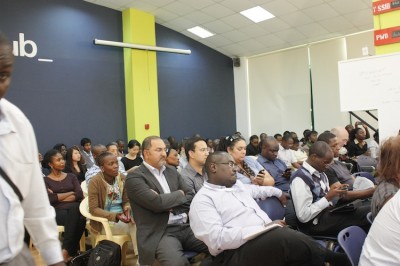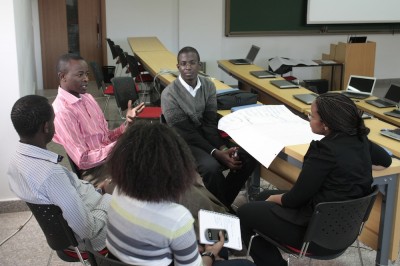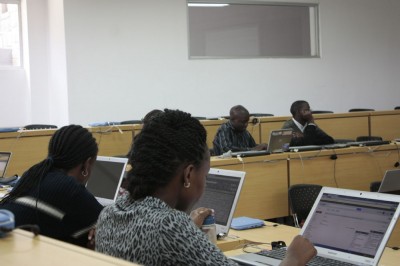Archive for the ‘user centered design’ tag
Mobile in East Africa. Is Reality Finally Getting Through?
Last week, an illustrious panel was joined by a reasonably sized audience at the iHub in Nairobi for a no-holds-barred discussion on the question is the Silicon Savannah hype or reality? Andrea Bonstedt triggered the discussion earlier in the week with an article published in The Star that resulted in animated discussions online. Sitting on the panel with Conrad Akunga and Njeri Rionge, she clarified her position on “Not every techie is an entrepreneur”. There’s a good summary of the evenings discussions on the iHub blog and in this follow-up piece by Andrea.
General consensus by the panel was that there’s still a long way to go and more to be done to improve the start-up ecosystem in Kenya. In conversations with a few private equity fund managers over the last week, Andrea’s claims were supported; there is still very little potential within the sector for fund managers to grow their pipelines from tech startups.
Meanwhile, inMobi announced it was scaling down its international operations and closing down offices in Africa and Russia. These markets will now be served by their London office. This at a time when the numbers show mobile penetration as rising exponentially on the continent. In the face of declining ARPU there’s increasing demand for data across Africa and the globe but the growth of smartphones on the continent is still slow. One plus one should equal two. Rising mobile penetration plus increasing demand for data should mean (somewhere in there) that there’s huge potential in the short term for businesses providing content and services on mobile via the internet. In my opinion, the potential is probably bigger than any commentator can say. It’s my view that the problem is in the timing. Apparently, users on the continent are on their own clock and exhibiting online behavior that deviates sufficiently from the norm common in the west as to make it less attractive for businesses like inMobi to justify a physical presence here.
Within this hype-vs-reality quandary lies a question which, due to inadequate answers, is probably one of the biggest reasons tech startups on the continent struggle. What do users in the mass market do with their mobile phones and how do they do it? A study by iHub Research funded by infoDev takes a stab at this problem from a high level perspective providing entrepreneurs planning to launch products/services designed for the mass market with useful analysis.
Hype gives us all something to aspire to. Reality makes sure only products that score well on the utility vs hype ratio stay alive. It’s natural selection at its best. Until we find actionable insights on user behavior related to mobile telephony on the continent we may have little to show but hype. Without actionable insights only chance can produce apps/services people would pay for.
But what can be done to give tech startups in sub Sahara Africa a fighting chance in this difficult operating environment? I can think of three quick ways.
- Less hype more work. I am all for hackathons, pitchfests and all manner of contests that put young entrepreneurs in the lime light. I believe they are an important part of the ecosystem allowing stories to spread and giving young people something to aspire to. Let’s add to these events metrics that reward entrepreneurs who successfully bring to market their products otherwise the only story we tell is about people who build cool things. Let’s also take these events on the road to cities and towns other than Nairobi, Dar es Salaam, Kampala and Kigali.
- Teach shipping. We should find ways of teaching basic entrepreneurship in our institutions so that we help young business owners understand how to build teams and run businesses. That way they know what to look for in someone to run things for them. Most of all, more focus should be put on equipping start-ups with the skills to ship products. It’s pointless building a great app if all it ever does is get whipped out at the next challenge/competition/pitchfest. Get customers or close up shop. Those who end up in formal employment would benefit from these skills as they, by necessity, include focus, project management and strategy.
- Think business. What are we building? Who shall use it? How will we get paid for it? How will they obtain it? How will we support them? How much will it cost us to do this? How will we grow to break even? We need to spend less focus on grants and more focus on building sustainable enterprises that make more money than is spent running them. I am always surprised by the number of tech startup owners who can’t answer 5 out of 7 of the questions above.
- Learn from people. It is difficult to become an expert in a problem users face until you have met them and spoken to them. Building a solution to a problem implies that one understands it enough to be somewhat of an expert on it. Basic design thinking skills coupled with lean methodologies can provide young businesses with the agility they need to learn quickly and launch compelling solutions. Putting your product out in the wild and learning from user experiences and feedback is invaluable to a young business. Leave the attitude at home and go out the door where you can learn from other people.
The reality isn’t pretty. The mobile technology industry in East Africa, though still in its infancy, has come along way already. In this hyper-connected age, we just haven’t come far enough fast enough.
Delivering Value Made Simple
“The rationale behind how a business creates, delivers and captures value.”
That’s the short version definition for the term ‘business model‘. For those with no background in economics or commerce (read techies) all this talk about ‘value’ can be too vague to be much good. It leaves too much to subjective interpretation. It needs to be less so. Less subjective interpretation on the innovators end and about the same as before on the consumer end. For purposes of this post, techies include those who make things like handbags, solar panels, furniture…as well as computer programmers.
Tech innovators typically need to ideate less from the comfort of their space (workshop/keyboard) and more from the environment their clients will be using their product or service. This means clients continue to judge the performance of the product using their existing schema and the innovator adopts their own interpretation of value to the users subjective interpretation.
So what does delivering value mean for a techpreneur in Africa? It boils down to job descriptions. What job is the client trying to get done and how does your new app/service/magic help them do it better, faster, cheaper and/or cooler? When clients choose to take the risk of investing money or time (or both) in trying your technology, they expect something to happen. Delivering on that expectation is your easiest definition of delivering value. It means innovators need to spend lots of time with the people they expect to serve with their technology in order to understand what this expectation would be.
But when is value actually delivered? Is it at point of sale? Is it at point of use? Is it at point of disposal? Is it at multiple areas? Social enterprises and civil society led projects generally tend to lose sight of this resulting in huge amounts of wasted resources and a muddied view of their sector in the public domain. For-profit organizations can be just as guilty of failing to understand their clients. Financial services businesses can be notorious for creating products that are poorly distributed or whose value is eroded at the point-of-use such as low density of ATMs resulting in long queues and high charges for clients wishing to close their accounts (point-of-disposal). Some products are essential enough and common enough to be almost impossible to differentiate at the product level. However, new value can be delivered through better distribution, better packaging, easier disposal or better branding that taps into the client’s aspirations.
So before you spend too much time building out some amazing new app, chair, bag or drone make the time to listen and watch your clients to understand what their lives are like and how your product can make a part of it better by helping them get a job done; or to put it in buzz words we all understand…
“Understand how your product or service empowers users across the value chain by synergistically delivering new value through innovative business models.”
or get more buzz words here 🙂
TweetWorkshop: Designing Apps for the Masses in Africa
This past week the Semacraft team was at Strathmore University holding a workshop for the MSc Telecommunications Innovation (Safaricom Academy) students on designing apps for the mass market in Africa. We are grateful to iLabAfrica for making the event possible.
It’s always great being at Strathmore University, the campus has a great sense of And the students have great energy. Our workshop was based on Semacraft’s basic innovation model called p5 which starts with people and keeps the user at the center of the innovation process throughout the service design lifecycle. A key part of the model requires the innovator to identify personas in their market who they would plan to address. It was impressive the number of personas the participants were able to come up with, some who are well represented throughout the planet’s growth markets. The potential for new disruptive ideas does lie among our young innovators. At Semacraft we look forward to being part of the process that brings to the surface the next generation of ideas that change the way people live and work in Africa.
This workshop was the first in a series designed to equip developers with better skills in business design and improve the quality of ideas launched by young tech innovators in East Africa. The workshop series will culminate in the launch of a handbook later in the year. The next workshop will also be at a Kenyan university later this month. Follow us on Twitter to stay updated.


